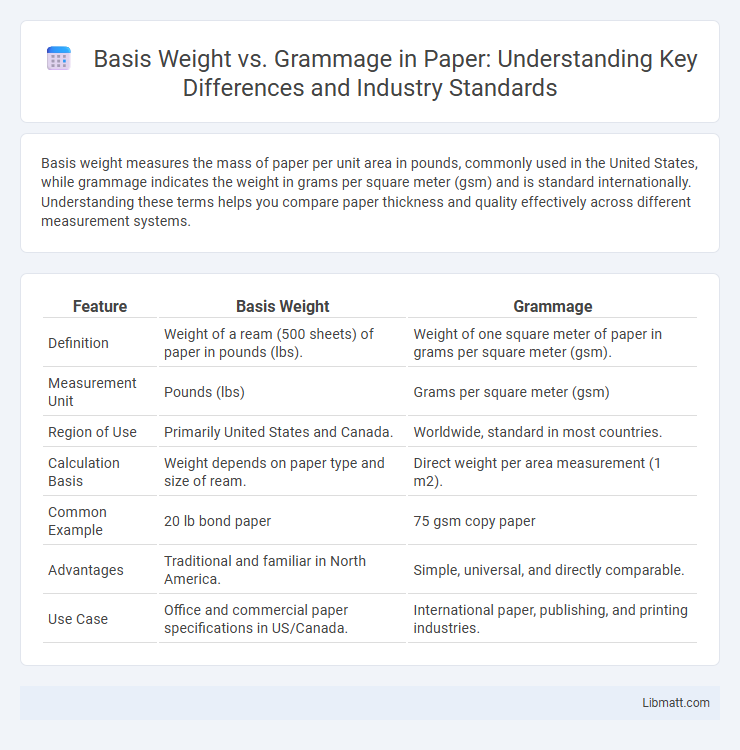Basis weight measures the mass of paper per unit area in pounds, commonly used in the United States, while grammage indicates the weight in grams per square meter (gsm) and is standard internationally. Understanding these terms helps you compare paper thickness and quality effectively across different measurement systems.
Table of Comparison
| Feature | Basis Weight | Grammage |
|---|---|---|
| Definition | Weight of a ream (500 sheets) of paper in pounds (lbs). | Weight of one square meter of paper in grams per square meter (gsm). |
| Measurement Unit | Pounds (lbs) | Grams per square meter (gsm) |
| Region of Use | Primarily United States and Canada. | Worldwide, standard in most countries. |
| Calculation Basis | Weight depends on paper type and size of ream. | Direct weight per area measurement (1 m2). |
| Common Example | 20 lb bond paper | 75 gsm copy paper |
| Advantages | Traditional and familiar in North America. | Simple, universal, and directly comparable. |
| Use Case | Office and commercial paper specifications in US/Canada. | International paper, publishing, and printing industries. |
Understanding Basis Weight and Grammage
Basis weight and grammage are essential paper measurement terms that help determine paper quality and suitability for specific uses. Grammage defines the weight of paper measured in grams per square meter (gsm), providing a direct and internationally recognized metric of paper density. Understanding your paper's grammage ensures accurate selection for printing or packaging needs compared to basis weight, which is primarily used in the U.S. and depends on the paper type and sheet size.
Key Differences Between Basis Weight and Grammage
Basis weight measures paper weight in pounds per ream (500 sheets) based on specific sheet sizes, commonly used in the United States. Grammage indicates the weight of paper in grams per square meter (g/m2), providing a standardized, metric measurement preferred internationally. Understanding these key differences helps You compare paper quality accurately across regions and industries.
The Importance in Paper Manufacturing
Basis weight and grammage are critical metrics in paper manufacturing that directly impact product quality and cost efficiency. Basis weight measures the weight of a ream of paper in pounds per 500 sheets, commonly used in North America, while grammage represents the mass of paper per square meter, favored internationally. Understanding these measurements ensures Your paper product meets specific thickness, strength, and printing requirements essential for various applications.
How to Measure Basis Weight
Basis weight is measured by weighing a specific size sheet of paper, typically 500 sheets, and is expressed in pounds (lbs), while grammage is the weight in grams per square meter (gsm). To measure basis weight, you first determine the weight of the ream and then calculate the weight per unit area based on the sheet size. Understanding your paper's basis weight helps ensure proper material selection for printing and packaging applications.
Calculating Grammage: Methods and Tools
Calculating grammage involves measuring the mass of paper in grams per square meter (gsm), which provides a standardized metric for comparing paper weight. Common methods include using precision scales to weigh a known area of the paper or employing specialized instruments like a basis weight scale designed for paper testing. Digital tools and software integrated with these scales enhance accuracy by automatically calculating grammage from the measured mass and area.
Industry Standards for Basis Weight and Grammage
Basis weight and grammage are crucial metrics in the paper and packaging industries, standardized by organizations like TAPPI and ISO for consistent quality control. Basis weight, primarily used in the United States, measures the weight of a ream of paper in pounds, while grammage, common internationally, quantifies the weight per square meter in grams. Industry standards ensure accurate specification and comparison of materials, facilitating global trade and manufacturing efficiency.
Common Applications in Printing and Packaging
Basis weight and grammage are crucial metrics in printing and packaging that determine paper thickness and durability, influencing material choice for specific applications. Basis weight, used primarily in the U.S., measures the weight of a ream of paper in pounds and is ideal for selecting cardstock, labels, and promotional materials requiring precise folds and durability. Grammage, measured in grams per square meter (gsm) internationally, guides the selection of flexible packaging, paperboard, and high-quality brochure printing, where consistent weight impacts print quality and product protection.
Impact on Product Quality and Performance
Basis weight and grammage both measure paper density but differ in units, with basis weight expressed in pounds per ream and grammage in grams per square meter (gsm). Grammage provides a more precise, standardized metric crucial for ensuring consistent product quality, especially in international markets. Variations in basis weight or grammage directly affect paper thickness, stiffness, and printability, impacting the performance and durability of finished products like packaging, labels, and printing materials.
Regional Variations in Terminology
Basis weight and grammage refer to the weight of paper but differ primarily in regional usage and measurement units. Basis weight, common in the United States, measures the weight in pounds of a ream (500 sheets) of paper in its basic size, while grammage, used internationally including Europe and Asia, indicates the weight in grams per square meter (gsm). Understanding these regional variations in terminology helps You accurately compare paper types and specifications across global markets.
Choosing the Right Measurement for Your Needs
Basis weight and grammage are key metrics used to measure paper thickness and quality, but they differ by region and application: basis weight is commonly used in the United States, representing the weight of a ream of paper in pounds, while grammage, prevalent internationally, expresses the weight in grams per square meter (gsm). Choosing the right measurement depends on your project's location and industry standards, as grammage provides a straightforward, size-independent metric, whereas basis weight varies with paper size and type. Understanding these distinctions ensures your selections align with printing requirements, durability, and overall material performance.
Basis weight vs grammage Infographic

 libmatt.com
libmatt.com